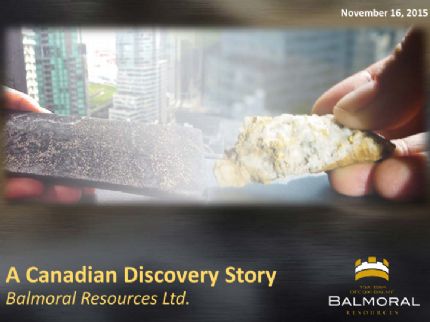 Reports Positive Metallurgical Results from Initial Testing of H3 Ni-Sulphide Zone at Grasset, Quebec
Reports Positive Metallurgical Results from Initial Testing of H3 Ni-Sulphide Zone at Grasset, Quebec
Vancouver, Sep 30, 2015 AEST (ABN Newswire) - Balmoral Resources Ltd ( TSE:BAR) (
TSE:BAR) ( BALMF:OTCMKTS) today announced the results of initial metallurgical testing conducted on drill core collected from the Company's wholly owned H3 Ni-Cu-PGE Zone located on the Grasset Project in Quebec. Initial testing of samples from two representative areas of the H3 Zone produced excellent nickel, copper and palladium recoveries. Locked cycle flotation tests performed using a simple and conventional flowsheet produced bulk nickel concentrates characterized by good nickel, copper and palladium grades. Based on the initial test work cobalt, platinum and gold also appear to have potential to provide payable credits in the concentrate.
BALMF:OTCMKTS) today announced the results of initial metallurgical testing conducted on drill core collected from the Company's wholly owned H3 Ni-Cu-PGE Zone located on the Grasset Project in Quebec. Initial testing of samples from two representative areas of the H3 Zone produced excellent nickel, copper and palladium recoveries. Locked cycle flotation tests performed using a simple and conventional flowsheet produced bulk nickel concentrates characterized by good nickel, copper and palladium grades. Based on the initial test work cobalt, platinum and gold also appear to have potential to provide payable credits in the concentrate.
Highlights:
- Locked Cycle Flotation Tests Produce Nickel Recoveries of 86.0 to 87.3%, Copper Recoveries of 93.5-94.4% and Palladium Recovery of 89%
- Initial Concentrate Grades of 13.4-13.8% Ni, 1.79-1.97% Cu and 10.15 to 10.61 g/t 3E (Au+Pt+Pd) Reported
Initial testing also indicates that the tailings produced from the recovery process would likely not be acid generating with pH values in the reducing range at 8.7 to 8.8. Metallurgical testing was performed on behalf of the Company by Blue Coast Research Ltd. of Parksville, British Columbia.
"We could not have asked for much better results from this initial phase of metallurgical testing of the H3 Zone" said Darin Wagner, President and CEO of Balmoral. "The reported nickel, copper and palladium recoveries rank in the upper quartile for producing and development stage nickel assets. On top of that the concentrates produced exhibit good nickel grades with potential for valuable copper, cobalt and precious metal credits and no significant contaminants. Blue Coast has suggested a number of potential paths to further optimize recoveries and concentrate grades as we move forward, but this is a great start."
METALLURGICAL TESTING
Head Assays and Mineralogy
Metallurgical testing was performed on two master composites ("MC-1" and "MC-2") with average nickel head grades of 1.87% and 1.29% nickel respectively (see Table 1, in link below). The two samples were selected as being representative of the two principal alteration types within the current outline of the H3 Zone. Both master composites display similar mineralogy with sulphides being comprised of pentlandite, chalcopyrite, pyrrhotite and pyrite. Electron microprobe analysis indicates that between 94% and 96% of the nickel in the master composites is deported to pentlandite. This high deportment to pentlandite is consistent with the Company's observations and the high nickel tenor of the nickel sulphides within the Zone.
In addition to the two master composites, twelve additional composites were collected and characterized by chemical assays and QEMSCAN automated mineralogical analysis. Overall, the twelve samples showed similar mineralogical characteristics to the two master composites. Four of the twelve exhibit moderate serpentine alteration similar to MC-1, with the other eight exhibiting lower levels of serpentine alteration, similar to MC-2.
Grindability
Grinding tests indicate the H3 sulphide zone exhibits moderate hardness, which should present no significant issues during milling. The Bond Rod Mill Work Index was recorded at 12.9 kWh/tonne and the Bond Ball Mill Work Index at 11.4 kWh/tonne. These values are toward the lower end of average values reported by currently producing nickel operations. MC-2 required approximately half the time to reach a grind of 80% ("p80") passing 100 ┬Ám vs. MC-1 as a result of the lower percentage of serpentine in MC-2. This suggests some variability in hardness within the Zone and additional grinding tests have been recommended by Blue Coast to better understand this variation.
Flotation - Locked Cycle Test Results
Flotation test work indicated that a simple and conventional rougher and three stage cleaner flowsheet, in conjunction with a primary grind of p80=65 ┬Ám, achieved the best combination of nickel recoveries and nickel concentrate grades. Results from locked cycle testing of MC-1 and MC-2, based on these parameters, are shown in Tables 2 and 3 (in link below). The results were consistent between the two composites with slightly higher recoveries and concentrate grades yielded by MC-2. These higher recoveries are likely a result of the slightly coarser pentlandite grain size in MC-2 which resulted in improved primary liberation of pentlandite.
Concentrates grading between 13.4 and 13.8% nickel were produced with nickel recoveries ranging between 86.0% and 87.3%. Copper recovery to concentrate was very high averaging 94%. Iron to MgO ratios were 5.9:1 and 6.9:1 respectively for MC-1 and MC-2 representing MgO grades of 3.2% and 3.9% for the two master composites. Minor element scans of the final concentrates did not detect the presence of any significant quantities of penalty elements.
The final locked cycle test concentrates were assayed for gold and PGE's with the results summarized below. Flotation conditions were not specifically optimized for precious metal recoveries as part of this initial testing program. Gold and PGE recoveries were based on a limited dataset of feed and concentrate assays, coupled with mass recoveries from the lock cycle tests, and thus are estimates only and should not be considered as robust as the base metal projections. Rhodium, osmium and iridium assays remain pending.
Rougher and cleaner flotation tests indicate that the most significant drivers of metallurgical performance are:
- Addition of Soda Ash and CMC (both standard reagents) for talc depression
- Primary grinds of approximately p80 passing 65 ┬Ám
- Sufficient cleaner flotation residence time to recover slower floating pentlandite
Recommendations for Further Work
Based on the success of the initial phase of metallurgical testing, Blue Coast has recommended the following additional tests in order to better characterize the metallurgical characteristics of the H3 Zone and optimize recoveries and concentrate grades:
- Variability hardness testing to determine the range of hardness within the Zone
- A further evaluation of the conditions which could increase the final concentrate grade by further depressing pyrite and pyrrhotite during flotation.
- Further evaluation of the cleaner circuit to optimize reagent addition and increase talc depression which could potentially enhance concentrate grades and recoveries
- Conduct additional flotation testing to determine the range of flotation responses and generate head grade/recovery relationships including additional precious metal testing
To view the release, please visit:
http://media.abnnewswire.net/media/en/docs/81058-TSE_BAR_30092015.pdf
About Balmoral Resources Ltd
 Balmoral Resources Ltd. (
Balmoral Resources Ltd. ( TSE:BAR) (
TSE:BAR) ( OTCMKTS:BALMF) is a Canadian-based discovery company focused on high-grade nickel and gold discoveries on its wholly owned, 700+ square kilometre Detour Trend Project in Quebec, Canada. With a philosophy of creating value through the drill bit and a focus on proven productive precious/base metal belts, Balmoral is following an established formula with a goal of maximizing shareholder value through discovery and definition of high-grade, Canadian base metal and gold assets.
OTCMKTS:BALMF) is a Canadian-based discovery company focused on high-grade nickel and gold discoveries on its wholly owned, 700+ square kilometre Detour Trend Project in Quebec, Canada. With a philosophy of creating value through the drill bit and a focus on proven productive precious/base metal belts, Balmoral is following an established formula with a goal of maximizing shareholder value through discovery and definition of high-grade, Canadian base metal and gold assets.



![abnnewswire.com]()
Related Companies
Social Media
Share this Article

 TSE:BAR) (
TSE:BAR) ( BALMF:OTCMKTS) today announced the results of initial metallurgical testing conducted on drill core collected from the Company's wholly owned H3 Ni-Cu-PGE Zone located on the Grasset Project in Quebec. Initial testing of samples from two representative areas of the H3 Zone produced excellent nickel, copper and palladium recoveries. Locked cycle flotation tests performed using a simple and conventional flowsheet produced bulk nickel concentrates characterized by good nickel, copper and palladium grades. Based on the initial test work cobalt, platinum and gold also appear to have potential to provide payable credits in the concentrate.
BALMF:OTCMKTS) today announced the results of initial metallurgical testing conducted on drill core collected from the Company's wholly owned H3 Ni-Cu-PGE Zone located on the Grasset Project in Quebec. Initial testing of samples from two representative areas of the H3 Zone produced excellent nickel, copper and palladium recoveries. Locked cycle flotation tests performed using a simple and conventional flowsheet produced bulk nickel concentrates characterized by good nickel, copper and palladium grades. Based on the initial test work cobalt, platinum and gold also appear to have potential to provide payable credits in the concentrate. Balmoral Resources Ltd. (
Balmoral Resources Ltd. ( TSE:BAR) (
TSE:BAR) ( OTCMKTS:BALMF) is a Canadian-based discovery company focused on high-grade nickel and gold discoveries on its wholly owned, 700+ square kilometre Detour Trend Project in Quebec, Canada. With a philosophy of creating value through the drill bit and a focus on proven productive precious/base metal belts, Balmoral is following an established formula with a goal of maximizing shareholder value through discovery and definition of high-grade, Canadian base metal and gold assets.
OTCMKTS:BALMF) is a Canadian-based discovery company focused on high-grade nickel and gold discoveries on its wholly owned, 700+ square kilometre Detour Trend Project in Quebec, Canada. With a philosophy of creating value through the drill bit and a focus on proven productive precious/base metal belts, Balmoral is following an established formula with a goal of maximizing shareholder value through discovery and definition of high-grade, Canadian base metal and gold assets.





